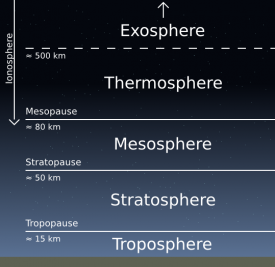Atmosphere
The Earth's atmosphere is a layer of gases surrounding our planet. This layer is retained by the gravity of the Earth. It is composed of "air", which contains 78% nitrogen, 21% oxygen, 0.93% argon, 0.039% carbon dioxide, as well as small amounts of other gases. The air also contains a variable amount of water vapour, on average 1%.
The atmosphere protects life on Earth from:
- absorbing ultraviolet solar radiation,
- warming the surface of the Earth through heat retention (greenhouse effect), and
- reducing the extreme temperature differences between day and night.

The atmosphere is separated into 5 distinct layers:
- The troposphere which extends from 0 to 8 km in altitude in the Poles and from 0 to 18 km in the equatorial regions;
- the stratosphere which extends from the tropopause (the boundary layer between the troposphere and the stratosphere) to the stratopause, which is found at about 50 km;
- the mesosphere which extends to the mesopause at 80 or 90 km;
- the ionosphere (or thermosphere) which extends from the mesopause to about 500 km;
- and the exosphere, the last layer, which extends between 500 and 1000 km, before the entrance into the interstellar vacuum.
An example of temperature stratification of the atmosphere is shown in the picture on the right. In the atmosphere, we observe the processes that we call "weather" mainly in the troposphere, described below in further details.
Troposphere
The troposphere is the lowest portion of the Earth's atmosphere. It contains approximately 90% of the atmosphere's mass and 99% of its water vapour and aerosols. It is the layer in which the "weather" occurs. The border between the troposphere and the next layer (stratosphere), called the tropopause, is a temperature inversion (temperature warming or less cold decrease).
The average height of the troposphere is approximately 17 km in the mid latitudes. It is higher in the tropical regions (up to 20 km) and shallower towards the Poles (up to 8 km in summer, and 6-7 km in winter). The lowest part of the troposphere, in which frictions with the Earth's surface influences the air flow, is the planetary boundary layer. This layer is typically a few hundred metres to 2 km deep, depending on the landform and time of day.
The troposphere is directly heated by the sunlight to a lesser extent. The largest part of the
heat is absorbed from the ground, which warms up in the sun. The air temperature decreases from the ground on
average by approximately 6.5°C per kilometre height. This is the "vertical atmospheric temperature gradient".
Specifically, the temperature decreases on average by 10°C per km altitude under dry-adiabatic (=cloudless)
conditions (dry adiabatic lapse rate = DALR) and about 6°C per km in altitude under moist-adiabatic (cloudy or
foggy) conditions (saturated adiabatic lapse rate = SALR).
In the tropopause, the temperature is of
approximately -75°C (at the Equator) to -45°C (at the Poles). Since warm gases rise and cold air drops, it mixes
within the troposphere, and this creates the "weather". In the ozone layer in the stratosphere, the temperature
starts rising again with increasing height (inversion), and this represents a mixing boundary.
Therefore, all processes affecting the weather occur in the troposphere. Heating leads to temperature differences and creates wind flows, clouds are formed by the existing water vapour, rain develops and cleans the troposphere from solved gases and solids.
Temperature layers in the troposphere
The temperature in the troposphere decreases with the altitude.
Actually, warm air should
rise. However, this does not happen - why? Since the density of air decreases with the altitude, the air in the
upper layers is lighter than the underlying, warmer air layers - that are, however, more dense because they are
under higher air pressure. Therefore, the warm air does not rise - or does it nevertheless? ;)
Sometimes, warm
air rises if air is particularly heated and becomes lighter. Then, it displaces the colder air above, and ascends
until it has expanded and cooled down so much that its weight is no longer lighter than that of the surrounding air.
This phenomenon mainly occurs in the first three kilometres, due to of the influence of the ground.



